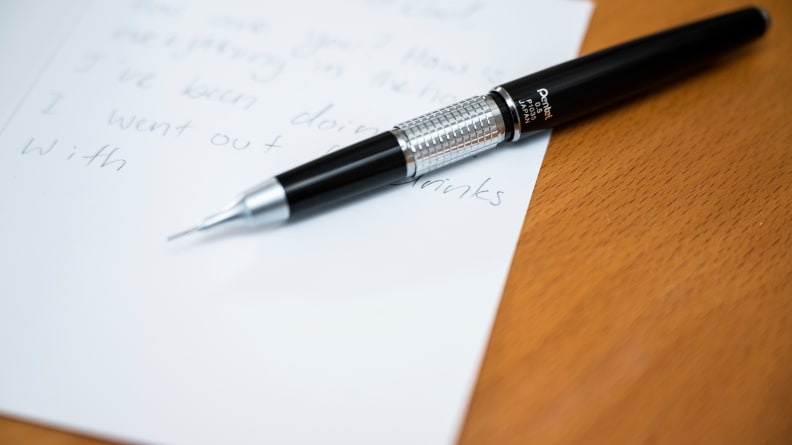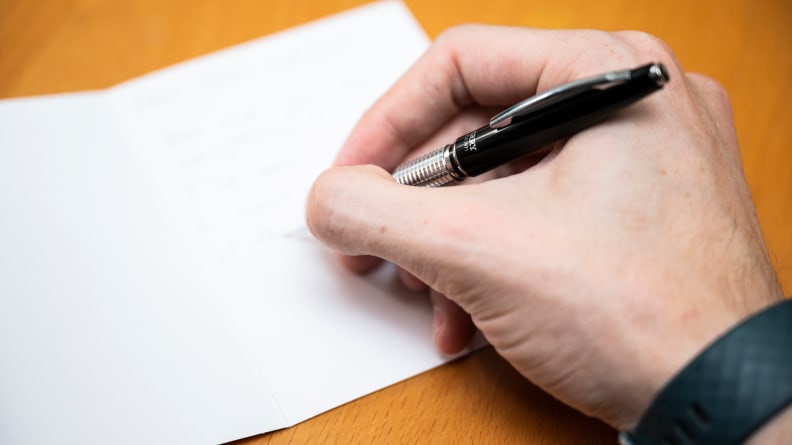Best Mechanical Pencil With Eraser

Credit: Reviewed / Betsey Goldwasser

The Pentel Kerry is the best mechanical pencil, for most people.
How We Tested Mechanical Pencils

Credit: Reviewed / Betsey Goldwasser
The only way to test mechanical pencils is to use them to write and draw—a lot.
The Tester
My name's Leah Fitzgerald. I'm a straight-up nerd when it comes to writing utensils.
I was that kid with her crayons sorted by color in a small toolbox snagged from the barn. I still keep my huge stash of pens, highlighters, markers and pencils (and, yes, crayons for coloring) sorted by type, though I've graduated to a nice pen roll for my fountain pens. Bleed-through is my pet peeve and a buttery soft page in a fresh notebook is my happy place.
I fell in love with mechanical pencils after a miserable cold snap froze all my ballpoint pens when I was a young reporter in Quebec.
The Tests
Each one of the mechanical pencils in this guide was tested over the course of a full day's worth of work, longhand letter writing, and note taking for a series of meetings. We also drew some diagrams with them and used a ruler and a helix for making circles. If the pencil came sporting an eraser, we tested it for how well it erased a heavier scribble of graphite and regular writing.
During testing, we used each mechanical pencil, we wrote on a variety of different paper types, including:
- A Hilroy notebook
- A Field Notes notepad
- A Rhodia Dot Pad,
- A Strathmore Drawing pad.
To test durability, each of the pencils was allowed to roll off a surface and fall a distance of 32.25 inches, onto a hardwood floor. After each of the pencils took the plunge, the lead inside was examined for breakage. Any damage to the pencils themselves was noted.
All of the pencils tested used 0.5 mm lead, except the Zebra M 301, which is available as 0.7 mm. We tested a 0.5 mm lead because it is widely available. Additionally, thinner lead can show any breakage issues more easily than its thicker counterpart.
How To Shop For A Mechanical Pencil
We stand by the options we've recommended in this guide. However, if you want to head out to buy a mechanical pencil on your own, there's a few things you should look for.
Build Quality: Good craftsmanship will keep your pencil in your hand for decades. A sturdy barrel with minimal give, machined parts (metal or plastic) that fit tightly together, with no visible seams (potential weak points) are all signs of a solidly built pencil.
Balance: It's personal where you prefer the weight, but a well-balanced pencil encourages a more relaxed hand position when writing, which reduces fatigue.
Easy to Fill: No fiddly mechanisms here. All of the pencils reviewed have a simple access point from the end of the pencil: remove the plug or eraser and add more lead.
Comfortable Grip: It's very much personal - do you need a straight side or a taper? Do you prefer smooth or textured? Do you want some extra cushioning?
Lead Size: Not all pencils are available in all lead sizes. If you want a special wider or narrower lead, your options will change from the standard 0.5 or 0.7 mm lead options. Narrower leads are great for precision drawing and drafting uses, and people with small handwriting often prefer fine and extra-fine equivalents. Wider leads give a bolder line for drawing and tracing. The wider leads are also more resilient and might fare better for anyone with a heavier hand when they write.
How Do Mechanical Pencils Work?
Inside the barrel of a mechanical pencil is a tube that holds leads—usually three, but sometimes more. When the tip of the lead you're using starts growing dull or running out, additional lead can be advanced by clicking the button on the pencil, which, in turn, activates a mechanism called a clutch. The clutch grabs onto the lead inside of the pencil and pulls or pushes it through the pipe at the tip.
No matter which mechanical pencil you end up using, it'll likely contain these parts:
- Plunger: The basic mechanism in most pencils. Uses gears powered by pushing the plunger to pull the lead through the pipe.
- Shake: A weight inside the mechanism creates the movement pulling the lead through the pipe.
- Click: Like a plunger, but the gears are driven from the side of the pencil rather than the top.
- Clutch: Some pencils have a clutch mechanism, which allows shorter lengths of lead to be fed through the pencil. This is more common in higher-end drafting pencils that use thin lead - it allows more of the lead to be used by the pencil.
- Pipe/Lead Sleeve: The thin tube that comes out of the barrel pencil, where the lead comes out. It supports the lead as the pencil moves along the paper, and is retractable on some pencils to reduce breakage.
All mechanical pencils need a certain length of lead available (usually at least a centimeter) in their clutch to maintain a grip on as you write. The last, short piece of lead will slip back as you write in almost all pencils. When this happens, it's best to eject it and start a fresh lead for the best performance.
Are Mechanical Pencils And Drafting Pencils The Same?
Drafting pencils support a much wider variety of lead sizes than mechanical pencils. Additionally, drafting pencils have a longer pipe, which makes them ideal for precision work as it allows a better view of what's happening on the paper.
Should I Use Graphite Or Lead Refills?
Lead is a misnomer as actual lead hasn't been used for writing since the ancient Romans and Egyptians used a lead stylus to write on papyrus.
When it comes to modern pencils, the black "lead" comes from carbon, either in the form of graphite or carbon mixed with a binder. Carbon refills will make what you write appear darker on the page. A graphite refill may have some binder in it as well. Carbon is often bound with clay, with higher proportions of clay to carbon leading to harder leads. Softer leads contain either wax or a polymer to bind the carbon or graphite. Some refills (Pentel Super Polymer, for instance) contain a core to make the lead more flexible and resilient when writing.
Finer quality leads for mechanical pencils are available in many more grades than the standard HB (or No. 2 equivalent). H is for hardness and B is for boldness. H leads get harder and lighter as the numbers go up, while B leads will get softer and darker as the numbers increase. Lead hardness also determines how dark a line the pencil will lay down. Leads on the B scale will put down darker lines (although you can create light lines with them as well,) but will also be easier to smudge.
A Note On Paper Quality
A good quality paper can make low-end mechanical pencils perform well.
The smooth texture of the Rhodia pad we used for testing, for example, made it difficult to notice any drag or catching from any of the pencils. The Hilroy Quad-Rule notebook, on the other hand, was noticeably rougher to the touch. This affected the way most of the pencils wrote, even causing some of them to snag the paper and tear it. This wasn't the case, however, with the medium texture Strathmore Drawing pad used in testing. The thicker paper prevented the snagging issue, but it did make it clear again which leads were prone to drag (and noise in a quiet room) as we wrote and drew.
Other Mechanical Pencils We Tested
More Articles You Might Enjoy
- The Best Kids Backpacks
- The Best Office Chairs
- The Best Standing Desks
- The Best Laptop Stands
Checking our work.
Our team is here for one purpose: to help you buy the best stuff and love what you own. Our writers, editors, and lab technicians obsess over the products we cover to make sure you're confident and satisfied. Have a different opinion about something we recommend? Email us and we'll compare notes.
Shoot us an email
Best Mechanical Pencil With Eraser
Source: https://www.reviewed.com/lifestyle/best-right-now/best-mechanical-pencils
Posted by: mcelfreshvies1948.blogspot.com

0 Response to "Best Mechanical Pencil With Eraser"
Post a Comment